The AMD Ryzen 9 3950X Review: 16 Cores on 7nm with PCIe 4.0
by Dr. Ian Cutress on November 14, 2019 9:00 AM ESTCPU Performance: Web and Legacy Tests
While more the focus of low-end and small form factor systems, web-based benchmarks are notoriously difficult to standardize. Modern web browsers are frequently updated, with no recourse to disable those updates, and as such there is difficulty in keeping a common platform. The fast paced nature of browser development means that version numbers (and performance) can change from week to week. Despite this, web tests are often a good measure of user experience: a lot of what most office work is today revolves around web applications, particularly email and office apps, but also interfaces and development environments. Our web tests include some of the industry standard tests, as well as a few popular but older tests.
We have also included our legacy benchmarks in this section, representing a stack of older code for popular benchmarks.
All of our benchmark results can also be found in our benchmark engine, Bench.
WebXPRT 3: Modern Real-World Web Tasks, including AI
The company behind the XPRT test suites, Principled Technologies, has recently released the latest web-test, and rather than attach a year to the name have just called it ‘3’. This latest test (as we started the suite) has built upon and developed the ethos of previous tests: user interaction, office compute, graph generation, list sorting, HTML5, image manipulation, and even goes as far as some AI testing.
For our benchmark, we run the standard test which goes through the benchmark list seven times and provides a final result. We run this standard test four times, and take an average.
Users can access the WebXPRT test at http://principledtechnologies.com/benchmarkxprt/webxprt/
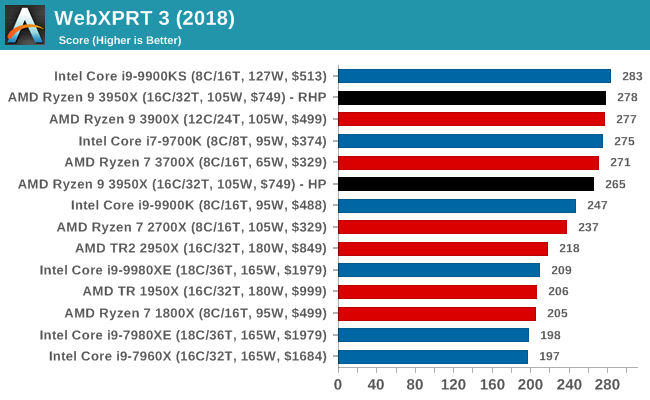
WebXPRT 2015: HTML5 and Javascript Web UX Testing
The older version of WebXPRT is the 2015 edition, which focuses on a slightly different set of web technologies and frameworks that are in use today. This is still a relevant test, especially for users interacting with not-the-latest web applications in the market, of which there are a lot. Web framework development is often very quick but with high turnover, meaning that frameworks are quickly developed, built-upon, used, and then developers move on to the next, and adjusting an application to a new framework is a difficult arduous task, especially with rapid development cycles. This leaves a lot of applications as ‘fixed-in-time’, and relevant to user experience for many years.
Similar to WebXPRT3, the main benchmark is a sectional run repeated seven times, with a final score. We repeat the whole thing four times, and average those final scores.
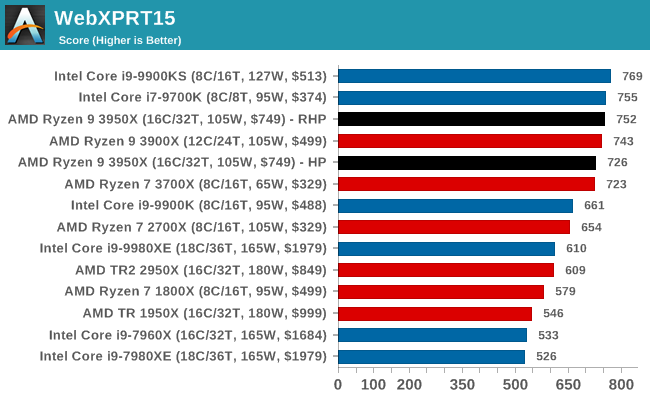
Speedometer 2: JavaScript Frameworks
Our newest web test is Speedometer 2, which is a accrued test over a series of javascript frameworks to do three simple things: built a list, enable each item in the list, and remove the list. All the frameworks implement the same visual cues, but obviously apply them from different coding angles.
Our test goes through the list of frameworks, and produces a final score indicative of ‘rpm’, one of the benchmarks internal metrics. We report this final score.
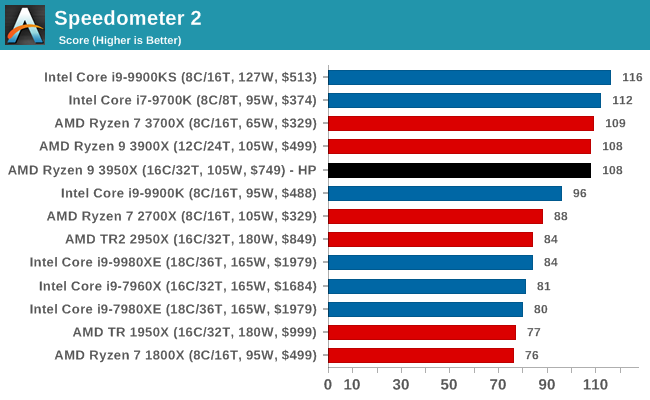
Google Octane 2.0: Core Web Compute
A popular web test for several years, but now no longer being updated, is Octane, developed by Google. Version 2.0 of the test performs the best part of two-dozen compute related tasks, such as regular expressions, cryptography, ray tracing, emulation, and Navier-Stokes physics calculations.
The test gives each sub-test a score and produces a geometric mean of the set as a final result. We run the full benchmark four times, and average the final results.

Mozilla Kraken 1.1: Core Web Compute
Even older than Octane is Kraken, this time developed by Mozilla. This is an older test that does similar computational mechanics, such as audio processing or image filtering. Kraken seems to produce a highly variable result depending on the browser version, as it is a test that is keenly optimized for.
The main benchmark runs through each of the sub-tests ten times and produces an average time to completion for each loop, given in milliseconds. We run the full benchmark four times and take an average of the time taken.

3DPM v1: Naïve Code Variant of 3DPM v2.1
The first legacy test in the suite is the first version of our 3DPM benchmark. This is the ultimate naïve version of the code, as if it was written by scientist with no knowledge of how computer hardware, compilers, or optimization works (which in fact, it was at the start). This represents a large body of scientific simulation out in the wild, where getting the answer is more important than it being fast (getting a result in 4 days is acceptable if it’s correct, rather than sending someone away for a year to learn to code and getting the result in 5 minutes).
In this version, the only real optimization was in the compiler flags (-O2, -fp:fast), compiling it in release mode, and enabling OpenMP in the main compute loops. The loops were not configured for function size, and one of the key slowdowns is false sharing in the cache. It also has long dependency chains based on the random number generation, which leads to relatively poor performance on specific compute microarchitectures.
3DPM v1 can be downloaded with our 3DPM v2 code here: 3DPMv2.1.rar (13.0 MB)
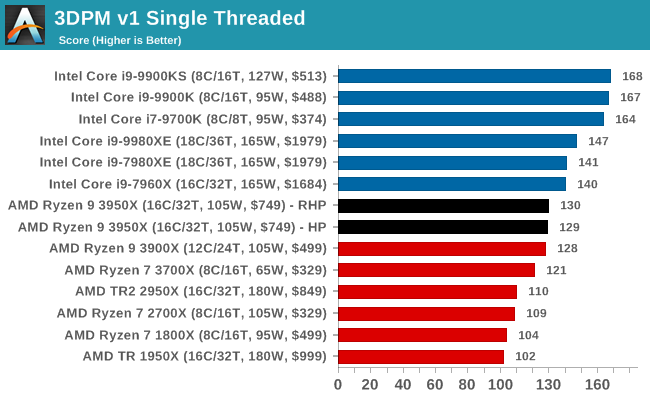
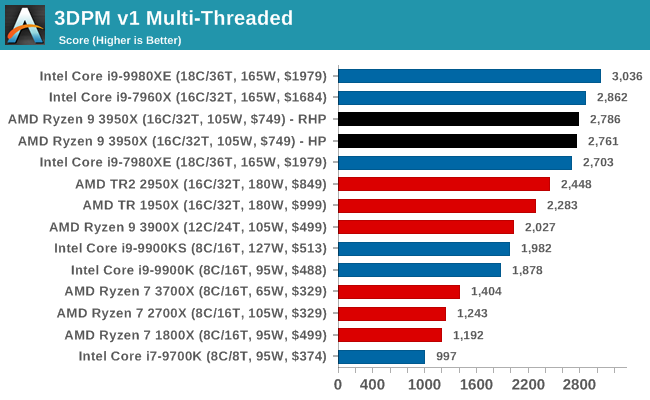
x264 HD 3.0: Older Transcode Test
This transcoding test is super old, and was used by Anand back in the day of Pentium 4 and Athlon II processors. Here a standardized 720p video is transcoded with a two-pass conversion, with the benchmark showing the frames-per-second of each pass. This benchmark is single-threaded, and between some micro-architectures we seem to actually hit an instructions-per-clock wall.
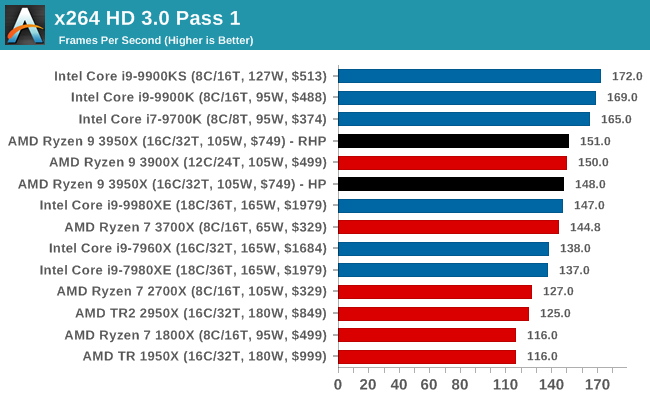
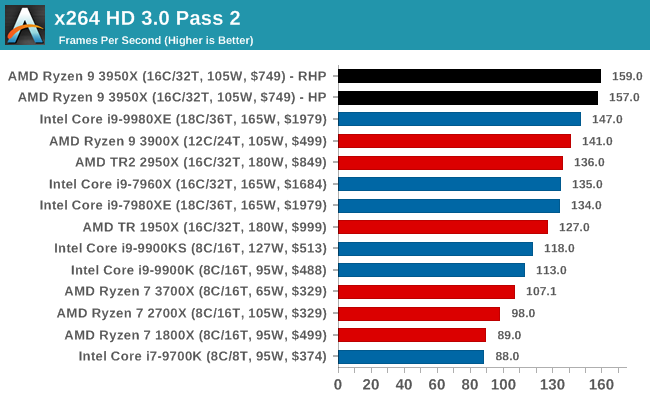
GeekBench4: Synthetics
A common tool for cross-platform testing between mobile, PC, and Mac, GeekBench 4 is an ultimate exercise in synthetic testing across a range of algorithms looking for peak throughput. Tests include encryption, compression, fast Fourier transform, memory operations, n-body physics, matrix operations, histogram manipulation, and HTML parsing.
I’m including this test due to popular demand, although the results do come across as overly synthetic, and a lot of users often put a lot of weight behind the test due to the fact that it is compiled across different platforms (although with different compilers).
We record the main subtest scores (Crypto, Integer, Floating Point, Memory) in our benchmark database, but for the review we post the overall single and multi-threaded results.

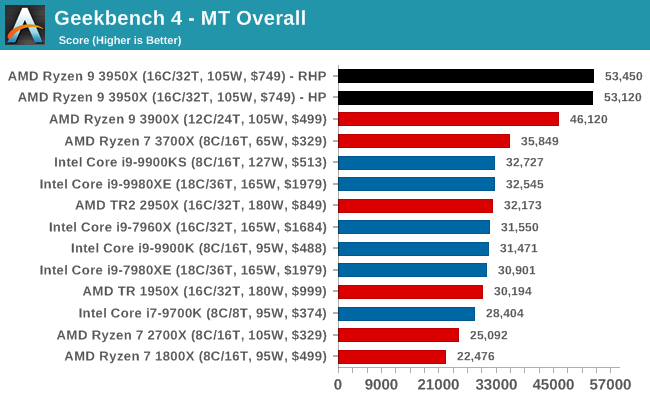










206 Comments
View All Comments
zmatt - Thursday, November 14, 2019 - link
Maybe they should stop using such an old and buggy game as a bench mark then since its trivial to hit more than acceptable frames with modern hardware.imaheadcase - Thursday, November 14, 2019 - link
Um they are using 1080p, its not GPU bound be any stretch of the imagination on the games they tested. lolSpunjji - Thursday, November 14, 2019 - link
Boost frequency isn't guaranteed, so it's not false advertising any more than Intel's TDP.If the games you're playing are a few years old and your GPU is sufficient to make the CPU the limit, you'll likely see no real-world benefit from anything above the Ryzen 3600X / Core i5 9600. Discussion of high-end CPUs rapidly becomes moot, even for that niche-within-a-niche.
shaolin81 - Thursday, November 14, 2019 - link
Problem isn't the chip, but the fact they tested it with High Performance profile, which nearly never parks idle cores and therefore there's nearly no change to hit max Turbo on single core. If they try Balanced profile, the would reach 4.7 or 4.75 more easily.I'm wondering how Anandtech doesn't know this.
GlossGhost - Tuesday, November 19, 2019 - link
Quite a lot of people don't know this. Maybe we, who know, are stupid instead?Targon - Thursday, November 14, 2019 - link
One thing to consider is motherboard and the VRMs on the motherboard, power supply, and even RAM. There was an issue causing slightly lower CPU performance prior to AGESA 1.0.0.3ABBA, and 1.0.0.4 is supposed to help a bit as well.You also don't take into account that the IPC of the new Ryzen chips is actually a bit better than what you see with the i9-9900k and ks. It may not be enough to offset the clock speed difference, but it does come into play.
Now, the other thing that will come into play is the security problems that keep showing up. Security mitigations are put into place, and Intel chips get another slowdown. In another year or two, Ryzen third generation vs. the 9900ks might actually be completely even with zero advantage to Intel. You may not be worried about security, but if an OS update puts in the security patches, your performance WILL drop.
We only have another 7 months until the next generation Ryzen chips come out with another 8 percent IPC improvements, will Intel still be on 14nm with a 10900k being the high end from Intel without any IPC improvements?
zmatt - Thursday, November 14, 2019 - link
What's the highest refresh rate you can get on gaming monitors today? 144hz right? When both Intel and AMD's best are exceeding 144fps in these benchmarks is there a real world difference between the two? I don't think so. You can only be as fast as your refresh rate ultimately.brantron - Thursday, November 14, 2019 - link
There are 240 Hz monitors with FreeSync and/or G-Sync, so you could (hopefully) run games somewhere between there and 144 Hz without stuttering.I've only seen comparisons to 60 Hz, though, and that's really going to depend on the game.
Winnetou - Thursday, November 14, 2019 - link
The highest refresh rate is 300hz now, thuogh it's only one monitor now. There are multiple 240hz ones though.Even so, your point is actually worthless here. Having a really high framerate does help with responsiveness and input lag. That's why top CS players still play at 720p low, on 600 FPS. For casuals like us it may be worthless, but for them it isn't. And maybe even for us it won't be, just too small of a difference to be quatifiable.
RSAUser - Friday, November 15, 2019 - link
The frame rate that high is to avoid lows.